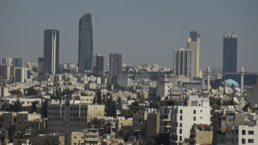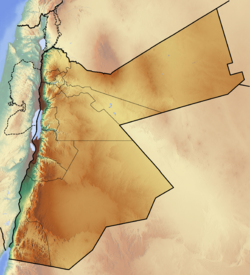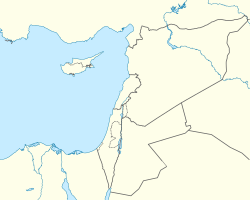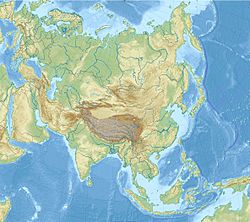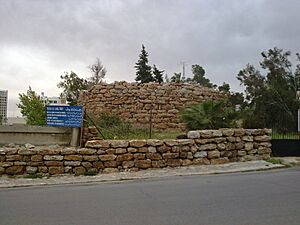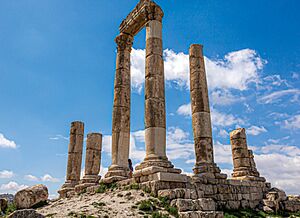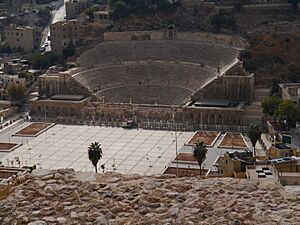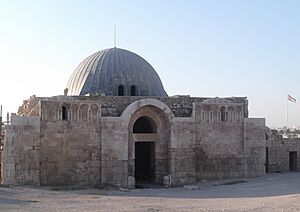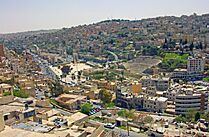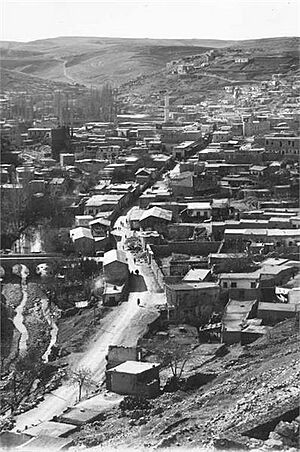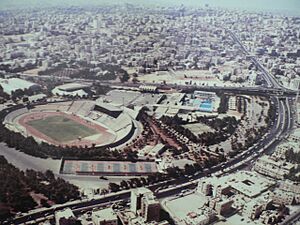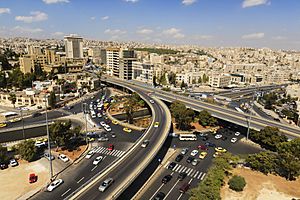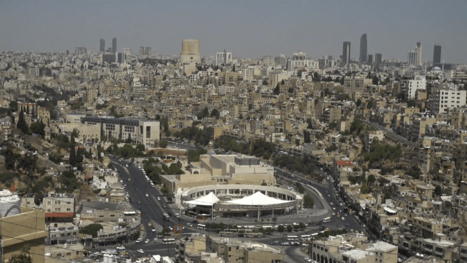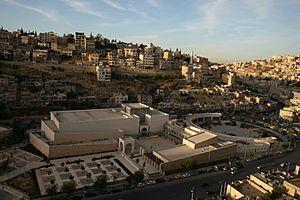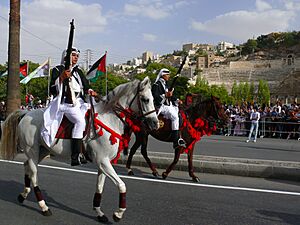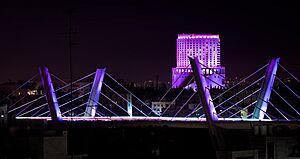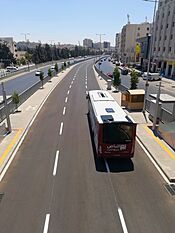Amman facts for kids
Quick facts for kids
Amman
عَمَّان
|
|||
|---|---|---|---|
|
Capital city
|
|||
|
New Abdali
King Abdullah I Mosque and Virgin Mary Church
Roman Theater and the Hashemite Plaza
Umayyad Palace at the Amman Citadel
Temple of Hercules
Abdoun Bridge
|
|||
|
|||
Nicknames:
|
|||
 |
|||
| Country | |||
| Governorate | Amman Governorate | ||
| Municipality | 1909 | ||
| Area | |||
| • Total | 1,680 km2 (650 sq mi) | ||
| Highest elevation | 1,100 m (3,600 ft) | ||
| Lowest elevation | 700 m (2,300 ft) | ||
| Population
(2021)
|
|||
| • Total | 4,061,150 | ||
| • Density | 2,380/km2 (6,200/sq mi) | ||
| Demonym(s) | Ammani | ||
| Time zone | UTC+3 | ||
| Postal code |
11110-17198
|
||
| Area code(s) | +962(6) | ||
Amman is the capital and largest city of Jordan. It's the country's main center for business, government, and culture. With over four million people in 2021, Amman is the biggest city in the Levant region (which includes countries like Jordan, Syria, Lebanon, Palestine, and Israel). It's also one of the largest cities in the Arab world.
Amman has a very long history. People first settled here around 8,000 BC in a place called 'Ain Ghazal. This is where some of the world's oldest human statues were found! The city was known as Rabat Aman in ancient times, serving as the capital of the Ammonite Kingdom. Later, the Greeks renamed it Philadelphia. In the 7th century AD, it became Amman again.
For many centuries, Amman went through periods of growth and quiet. It was largely empty from the 1400s until 1878. Then, the Ottoman Empire encouraged people from Circassia to settle there. The city grew quickly after the Hejaz railway was built in 1904.
Amman became the capital of Transjordan in 1921. This led to even faster growth as many people moved there. Over the years, Amman has welcomed many refugees from nearby countries. The city was first built on seven hills, but now it spreads across 19 hills and 22 areas. East Amman has many historic sites, while West Amman is more modern and a business hub.
Amman is a popular place to visit, with about one million tourists in 2018. It has a fast-growing economy and is seen as an important global city. Many international companies choose Amman for their offices in the Middle East.
Contents
- What's in a Name? The Story of Amman's Name
- A Journey Through Time: Amman's History
- Geography: Amman's Landscape
- Economy: How Amman Works
- Demographics: Who Lives in Amman?
- Cityscape: The Look of Amman
- Culture: Life in Amman
- Transportation: Getting Around Amman
- Education: Learning in Amman
- Twin Towns – Sister Cities
- Images for kids
- See Also
What's in a Name? The Story of Amman's Name
Amman gets its name from the ancient Ammonites. They were a people whose capital city this was back in the 13th century BC. They called it Rabat ʿAmmān, which meant "Capital" or "King's Quarters".
Later, a Greek ruler named Ptolemy II Philadelphus took over the city. He renamed it "Philadelphia," which means "brotherly love" in Greek. He named it after himself! But in the 7th century AD, when the Rashidun Caliphate took control, they brought back its old name, Amman.
A Journey Through Time: Amman's History
Ancient Beginnings: The Neolithic Period
The ancient site of ʿAin Ghazal is now on the edge of modern Amman. About 9,000 years ago (around 7000 BC), it was a large village. It had about 3,000 people living in rectangular mud-brick houses.
In 1983, archaeologists found some amazing human statues there. These statues are made of white plaster with painted eyes. They found 32 figures, some full bodies and some busts (upper bodies). A few even had two heads!
Iron Age: The Ammonites and Their Kingdom
In the 13th century BC, Amman was the capital of the Ammonite Kingdom. It was called "Rabat Amman" then. The city was rich in natural resources like sandstone and limestone. It also had good farms, making it an important stop on the King's Highway. This was an old trade route connecting Egypt with Mesopotamia and Syria.
The Ammonites earned a lot of money from trade. Their main god was Milcom. The city of Amman is mentioned several times in the Hebrew Bible. It was conquered by different empires over time, including the Assyrians, Babylonians, and Persians. You can still see some Ammonite ruins in Amman, like Rujm Al-Malfouf and parts of the Amman Citadel.
Classical Times: Greeks and Romans
When Alexander the Great conquered the Middle East, Greek culture spread. The Greeks founded new cities in what is now Jordan, including Amman. Ptolemy II Philadelphus, an Egyptian ruler, rebuilt the city and named it "Philadelphia."
Later, the Romans took over in 63 BC. They ruled for 400 years! Philadelphia became part of the Decapolis League, a group of ten Greek cities. This helped the city's economy grow.
Many Roman ruins still stand in Amman today. These include the Temple of Hercules at the Amman Citadel, the large Roman Theatre, and the Odeon. The Roman Theatre could hold 6,000 people and was built to protect the audience from the sun. The Odeon was smaller, with 500 seats, and is still used for concerts today!
Islamic Era: From the 7th to 15th Centuries
In the 630s, the Rashidun Caliphate conquered the region. Philadelphia was renamed "Amman" by the Muslims. Many people already spoke Arabic, which helped the city join the new caliphate. The Umayyad rulers built a large palace on the Amman Citadel hill, which you can still see today.
Amman's importance changed over time. It was damaged by earthquakes, but later became a regional capital again. During the Mamluk era (from the late 1200s to early 1500s), Amman was a busy town with farms. However, by the 15th century, its importance declined again. From then until 1878, Amman was mostly empty, used only by farmers and Bedouin tribes.
Modern Amman: From 1878 to Today
Amman began to be settled again in 1878. Many Muslim Circassians moved there after being displaced from the Ottoman Balkans. The Ottoman government wanted them to settle in Amman to help secure the trade route. The first Circassian settlers even used stones from the old Roman theater to build their homes!
The city grew a lot after the Hejaz Railway was built in 1903. This railway connected Damascus and Medina, making Amman an important trading center. Merchants from other cities moved to Amman, and its first city council was set up in 1909.
During World War I, Amman was a key location because of the railway. After the war, in 1921, Amman was chosen as the capital of the new state of Transjordan. This made the city grow even faster. Many people from other parts of Jordan and Palestine moved to Amman. By the 1930s, the population was around 10,000.
Jordan became independent in 1946, and Amman remained its capital. The city has continued to grow, welcoming many people from neighboring countries during times of conflict. For example, many Palestinians arrived after the 1948 and 1967 wars. Later, Iraqis came after the 1991 and 2003 wars, and Syrians since 2011.
In 2005, Amman faced challenges to its safety. However, Jordan's security has greatly improved since then, and no major attacks have been reported. In recent years, Amman has seen a big boom in its economy, culture, and urban development. New neighborhoods are being built quickly to keep up with the growing population.
Geography: Amman's Landscape
Amman is located on the East Bank Plateau. This area has three main valleys running through it. The city was originally built on seven hills, but now it covers many more. The different areas of Amman are often named after the hills or valleys they are on. The city's elevation ranges from about 700 to 1100 meters (2,300 to 3,600 feet) above sea level.
Climate: Weather in Amman
Amman has a climate that changes depending on where you are in the city. Western and northern parts have a hot-summer Mediterranean climate. This means hot, dry summers and mild, wet winters. Eastern and southern parts are more semi-arid, which is drier.
Summers in Amman are long and usually have mild heat with nice breezes. Spring is short but warm, usually in April and May. Winter starts around late November and lasts until March. Temperatures are cooler, and it might snow once or twice a year, especially in the higher areas.
The amount of rain varies across the city. Western areas get more rain than eastern areas. Rain mostly falls between November and April. Amman can also experience heavy fog about 120 days a year. Because of the different elevations, the weather can be very different from one neighborhood to another. For example, it might be snowing in the higher western parts while it's just raining downtown.
| Climate data for East Amman, Amman Civil Airport, elevation: 779 m or 2555 ft | |||||||||||||
|---|---|---|---|---|---|---|---|---|---|---|---|---|---|
| Month | Jan | Feb | Mar | Apr | May | Jun | Jul | Aug | Sep | Oct | Nov | Dec | Year |
| Record high °C (°F) | 23.0 (73.4) |
27.3 (81.1) |
32.6 (90.7) |
37.0 (98.6) |
38.7 (101.7) |
40.8 (105.4) |
43.5 (110.3) |
43.7 (110.7) |
40.0 (104.0) |
37.6 (99.7) |
31.0 (87.8) |
27.5 (81.5) |
43.7 (110.7) |
| Mean daily maximum °C (°F) | 12.7 (54.9) |
13.9 (57.0) |
17.6 (63.7) |
23.3 (73.9) |
27.9 (82.2) |
30.9 (87.6) |
32.5 (90.5) |
32.7 (90.9) |
30.8 (87.4) |
26.8 (80.2) |
20.1 (68.2) |
14.6 (58.3) |
23.7 (74.66) |
| Daily mean °C (°F) | 8.5 (47.3) |
9.4 (48.9) |
12.4 (54.3) |
17.1 (62.8) |
21.4 (70.5) |
24.6 (76.3) |
26.5 (79.7) |
26.6 (79.9) |
24.6 (76.3) |
21.0 (69.8) |
15.0 (59.0) |
10.2 (50.4) |
18.1 (64.6) |
| Mean daily minimum °C (°F) | 4.2 (39.6) |
4.8 (40.6) |
7.2 (45.0) |
10.9 (51.6) |
14.8 (58.6) |
18.3 (64.9) |
20.5 (68.9) |
20.4 (68.7) |
18.3 (64.9) |
15.1 (59.2) |
9.8 (49.6) |
5.8 (42.4) |
12.5 (54.5) |
| Record low °C (°F) | −4.5 (23.9) |
−4.4 (24.1) |
−3.0 (26.6) |
−3.0 (26.6) |
3.9 (39.0) |
8.9 (48.0) |
11.0 (51.8) |
11.0 (51.8) |
10.0 (50.0) |
5.0 (41.0) |
0.0 (32.0) |
−2.6 (27.3) |
−4.5 (23.9) |
| Average precipitation mm (inches) | 60.6 (2.39) |
62.8 (2.47) |
34.1 (1.34) |
7.1 (0.28) |
3.2 (0.13) |
0.0 (0.0) |
0.0 (0.0) |
0.0 (0.0) |
0.1 (0.00) |
7.1 (0.28) |
23.7 (0.93) |
46.3 (1.82) |
245.0 (9.65) |
| Average precipitation days | 11.0 | 10.9 | 8.0 | 4.0 | 1.6 | 0.1 | 0.0 | 0.0 | 0.1 | 2.3 | 5.3 | 8.4 | 51.7 |
| Mean monthly sunshine hours | 179.8 | 182.0 | 226.3 | 266.6 | 328.6 | 369.0 | 387.5 | 365.8 | 312.0 | 275.9 | 225.0 | 179.8 | 3,289.7 |
| Source 1: Jordan Meteorological Department | |||||||||||||
| Source 2: NOAA (sun 1961–1990), Pogoda.ru.net (records) | |||||||||||||
| Climate data for West Amman, University of Jordan, elevation: 1000 m or 3280 ft | |||||||||||||
|---|---|---|---|---|---|---|---|---|---|---|---|---|---|
| Month | Jan | Feb | Mar | Apr | May | Jun | Jul | Aug | Sep | Oct | Nov | Dec | Year |
| Record high °C (°F) | 21.0 (69.8) |
25.5 (77.9) |
30.5 (86.9) |
35.0 (95.0) |
36.5 (97.7) |
38.5 (101.3) |
41.5 (106.7) |
41.5 (106.7) |
38.0 (100.4) |
35.5 (95.9) |
29.0 (84.2) |
25.5 (77.9) |
41.5 (106.7) |
| Mean daily maximum °C (°F) | 10.5 (50.9) |
12.0 (53.6) |
15.5 (59.9) |
21.5 (70.7) |
26.0 (78.8) |
29.0 (84.2) |
30.5 (86.9) |
30.5 (86.9) |
29.0 (84.2) |
25.0 (77.0) |
18.0 (64.4) |
12.5 (54.5) |
21.5 (70.7) |
| Daily mean °C (°F) | 6.5 (43.7) |
7.5 (45.5) |
10.5 (50.9) |
15.0 (59.0) |
19.5 (67.1) |
22.5 (72.5) |
24.5 (76.1) |
24.5 (76.1) |
23.0 (73.4) |
19.0 (66.2) |
13.0 (55.4) |
8.0 (46.4) |
16.1 (61.0) |
| Mean daily minimum °C (°F) | 2.0 (35.6) |
3.0 (37.4) |
5.0 (41.0) |
9.0 (48.2) |
13.0 (55.4) |
16.5 (61.7) |
18.5 (65.3) |
18.5 (65.3) |
16.0 (60.8) |
13.0 (55.4) |
8.0 (46.4) |
4.0 (39.2) |
10.5 (50.9) |
| Record low °C (°F) | −9.0 (15.8) |
−6.5 (20.3) |
−5.0 (23.0) |
−5.0 (23.0) |
2.0 (35.6) |
7.0 (44.6) |
9.0 (48.2) |
9.0 (48.2) |
8.0 (46.4) |
3.0 (37.4) |
−2.0 (28.4) |
−4.5 (23.9) |
−9.0 (15.8) |
| Average precipitation mm (inches) | 132.5 (5.22) |
132.5 (5.22) |
75.0 (2.95) |
15.0 (0.59) |
7.0 (0.28) |
0.0 (0.0) |
0.0 (0.0) |
0.0 (0.0) |
0.2 (0.01) |
15.0 (0.59) |
50.0 (1.97) |
100.0 (3.94) |
525.0 (20.67) |
| Average precipitation days | 13.0 | 12.0 | 10.0 | 4.5 | 1.5 | 0.0 | 0.0 | 0.0 | 0.5 | 3.5 | 7.5 | 11.0 | 63.5 |
| Source 1: Jordan Meteorological Department | |||||||||||||
| Source 2: NOAA (sun 1961–1990), Pogoda.ru.net (records) | |||||||||||||
| Jan | Feb | Mar | Apr | May | Jun | Jul | Aug | Sep | Oct | Nov | Dec | Year |
|---|---|---|---|---|---|---|---|---|---|---|---|---|
| 3 | 5 | 7 | 9 | 10 | 12 | 12 | 11 | 9 | 6 | 4 | 3 | 7.5 |
Economy: How Amman Works
Banking: A Strong Financial Center
Jordan's economy relies a lot on its banking sector. Even with challenges in the region, Jordan's banks have kept growing. Amman is home to the international Arab Bank, one of the biggest financial groups in the Middle East. It has over 600 branches in 30 countries!
Tourism: Welcoming Visitors
Amman is a popular city for tourists. It's the 4th most visited Arab city. In 2011, about 1.8 million tourists visited Amman and spent over $1.3 billion. The city is investing a lot in its transportation to make it easier for visitors to get around.
Amman is also a major center for medical tourism in the Middle East. Many people come here for medical treatments. Jordan gets the most medical tourists in the region and is fifth worldwide.
Business: A Growing Hub
Amman is becoming a big business hub. New buildings and projects are constantly changing the city's skyline. Many businesses moved to Amman after the 2003 Iraq War. Queen Alia International Airport, south of Amman, is a major airport for the region.
Big companies like Hikma Pharmaceuticals (one of the Middle East's largest medicine companies) and Aramex (a big shipping company) are based in Amman. Amman is also a top choice for international companies looking to set up offices in the Middle East and North Africa.
Demographics: Who Lives in Amman?
| Historical population of Amman | ||
|---|---|---|
| Year | Historical population | ±% |
| 7250 BC | 3,000 | — |
| 1879 | 500 | −83.3% |
| 1906 | 5,000 | +900.0% |
| 1930 | 10,000 | +100.0% |
| 1940 | 20,000 | +100.0% |
| 1952 | 108,000 | +440.0% |
| 1979 | 848,587 | +685.7% |
| 1999 | 1,864,500 | +119.7% |
| 2004 | 2,315,600 | +24.2% |
| 2010 | 2,842,629 | +22.8% |
| 2015 | 4,007,526 | +41.0% |
| Nationality | Population (2015) |
|---|---|
| 435,578 | |
| 390,631 | |
| 308,091 | |
| 121,893 | |
| 27,109 | |
| 21,649 | |
| Other | 147,742 |
In 2015, Amman's population was over 4 million people. This means about 42% of Jordan's entire population lives in Amman! The city's population has grown a lot because of people moving there, especially during the 20th century. In 1890, there were only about 1,000 people, but by 1990, it was 1 million.
Many people in Amman have Palestinian roots. The two main groups are Arabs of Palestinian or Jordanian descent. Other ethnic groups make up a small part of the population. Several large Palestinian refugee camps exist around the center of Amman.
Because many people have moved to Amman from different places, the city is developing its own unique Arabic dialect. Younger generations are starting to call themselves "Ammani," showing their connection to the city.
Religion: Faith in Amman
Amman is mostly a Sunni Muslim city, and it has many mosques. One of the most important is the King Abdullah I Mosque, built between 1982 and 1989. It has a beautiful blue mosaic dome and can hold 3,000 people for prayer. The Abu Darweesh Mosque is known for its unique black-and-white pattern.
Many Christians from all over Jordan have also moved to Amman. The nearby town of Fuheis is mostly Christian. There are also a few historic churches in the Umm ar-Rasas ruins, which were once Roman military camps.
Cityscape: The Look of Amman
Downtown Amman, also called Al-Balad, is the old city center. Even though the city has grown a lot around it, it still has its unique charm. Jabal Amman is a popular area with markets, museums, and ancient buildings. It's also home to the famous Rainbow Street and the cultural Souk Jara market.
Architecture: Buildings in Amman
Most residential buildings in Amman are covered with white or beige limestone or sandstone. They usually have balconies on each floor. Hotels and commercial buildings might use stone, plastic, or glass.
High-Rise Buildings: Modern Towers
In west Amman, you'll find the Jordan Gate, a large project with two tall buildings connected by a lower section. The New Abdali district is another modern area with a mall, a boulevard, hotels, and many commercial and residential towers. This district is becoming a new business center for Amman.
The first phase of New Abdali has seven towers and attracts many businesses. A second phase is planned, which will include a large conference center and more towers with hotels, apartments, and medical facilities.
Culture: Life in Amman
Museums: Exploring History and Art
The biggest museum in Jordan is The Jordan Museum. It holds important archaeological finds, like parts of the Dead Sea Scrolls and the ancient statues from 'Ain Ghazal. Other museums include the Jordan National Gallery of Fine Arts, the Jordan Archaeological Museum, and The Children's Museum Jordan.
Lifestyle: What to Do in Amman
Amman is known as one of the more open cities in the Arab world. Many people from other countries and college students come to live, study, or work here. The food scene in Amman is amazing, with everything from traditional shawerma and falafel to international restaurants.
Large shopping malls have been built in Amman, like Mecca Mall, City Mall, and Abdali Mall. Wakalat Street is a special street just for pedestrians, with many famous clothing brands. The Sweifieh area is also a major shopping district.
Amman has many places for entertainment and social gatherings, especially in West Amman. These places are popular with Jordan's young population. The city also hosts cultural events like the annual Amman Summer Festival. Souk Jara is a popular weekly outdoor market during the summer.
Cuisine: The Taste of Amman
Ammani food is a mix of different cuisines from the region. It combines fresh vegetables from Lebanon, crispy falafels from Syria, and juicy kebabs from Egypt. It's part of the food of the Levant, which is the ancient name for the area between the Mediterranean Sea and the Arabian Peninsula. Amman's street food scene makes its cuisine truly special.
Sports: Games and Competitions
Amman is home to popular football clubs like Al-Wehdat and Al-Faisaly. They have a big rivalry in local football. Amman also hosted the 2016 FIFA U-17 Women's World Cup.
The city has hosted international athletics championships and the Jordan Rally, which is part of the FIA World Rally Championship. Newer sports like skateboarding and rugby are also growing in popularity. In 2014, a large concrete skatepark called 7Hills Skatepark was built in Downtown Amman.
{{wide image|Amman Sport City Panorama.jpg|880px|align-cap=center|A panoramic view of Amman International Stadium in the Sport City.]]
Media and Music: Sounds and Stories
Most of Jordan's radio stations, newspapers, and news channels are based in Amman. The first radio station, Hunna Amman, started in 1959. Popular daily newspapers include Alghad, Ad-Dustour, and Al Ra'i. The two most popular Jordanian TV channels, Ro'ya TV and JRTV, are also in Amman.
Besides mainstream music, Amman has a growing independent music scene. Many local bands have fans across the Arab world. They play different types of music, from heavy metal to Arabic Rock, jazz, and rap. The Roman Theater hosts the Al-Balad Music Festival every August, where local and regional bands perform.
Events: What's Happening in Amman
Amman hosts many exciting events throughout the year. These include Red Bull-sponsored events, the Jerash Festival, the Al-Balad Music Festival, and the Amman Marathon. You can also find the Made in Jordan Festival and the Amman Book Festival.
Many cultural events take place at the Roman and Odeon Theaters, the King Hussein Business Park, and the Royal Cultural Center.
Transportation: Getting Around Amman
Airports: Flying In and Out
The main airport for Amman is Queen Alia International Airport, located about 30 kilometers (19 miles) south of the city. It's the biggest international airport in Jordan and the main hub for Royal Jordanian, the country's airline. The airport has been expanded to handle over 16 million passengers each year. It's considered a very modern airport and has won awards for being one of the best in the Middle East.
A smaller airport, Amman Civil Airport, mainly handles domestic flights and flights to nearby countries.
Roads: Driving in the City
Amman has a large road network with many bridges and tunnels because of its hilly landscape. Eight large roundabouts, called "circles," are used as landmarks. A great example is the Abdoun Bridge, which crosses Wadi Abdoun and connects different parts of the city. It's a famous landmark and the first curved suspended bridge in Jordan.
The city's rapid growth has led to more traffic, especially in summer. A ring road has been built around the city to help direct traffic away from the center and improve air quality.
Bus and Taxi: Public Transport
Amman has frequent bus connections to other cities in Jordan and neighboring countries. Inside the city, you can use buses and taxis. Service taxis often follow fixed routes and are affordable. The main bus and taxi stations are Abdali and Raghadan Central Bus Station. Taxis are a very common way to get around Amman because they are easy to find and not expensive.
The Amman Bus and the Amman Bus Rapid Transit (BRT) systems serve the city. The BRT system started operating in 2021 and 2022. It has two routes that connect different parts of the city, with air-conditioned buses, security cameras, and free internet. You can buy tickets online or with a rechargeable card.
Education: Learning in Amman
Amman is a major center for education in the region. It has the highest number of schools and universities in Jordan. There are 20 universities in Amman. The University of Jordan is the largest public university in the city. Amman also has many private schools, including Jubilee School and Amman Baccalaureate School.
Some of the universities in Amman include:
- University of Jordan
- Al-Ahliyya Amman University
- Al-Isra University
- Al-Zaytoonah University of Jordan
- Amman Arab University
- Applied Science University
- Arab Open University
- German-Jordanian University: Amman Branch
- Middle East University
- University of Petra
- Philadelphia University
- Princess Sumaya University for Technology
- World Islamic Sciences and Education University
Twin Towns – Sister Cities
Amman is twinned with many cities around the world. This means they have special partnerships to promote cultural and economic ties.
 Muscat, Oman (1986)
Muscat, Oman (1986) Jeddah, Saudi Arabia (1988)
Jeddah, Saudi Arabia (1988) Cairo, Egypt (1988)
Cairo, Egypt (1988) Rabat, Morocco (1988)
Rabat, Morocco (1988) Sanaa, Yemen (1989)
Sanaa, Yemen (1989) Islamabad, Pakistan (1989)
Islamabad, Pakistan (1989) Ankara, Turkey (1992)
Ankara, Turkey (1992) Khartoum, Sudan (1993)
Khartoum, Sudan (1993) Doha, Qatar (1995)
Doha, Qatar (1995) Istanbul, Turkey (1997)
Istanbul, Turkey (1997) Algiers, Algeria (1998)
Algiers, Algeria (1998) Bucharest, Romania (1999)
Bucharest, Romania (1999) Nouakchott, Mauritania (1999)
Nouakchott, Mauritania (1999) Tunis, Tunisia (1999)
Tunis, Tunisia (1999) Sofia, Bulgaria (2000)
Sofia, Bulgaria (2000) Beirut, Lebanon (2000)
Beirut, Lebanon (2000) Pretoria, South Africa (2002)
Pretoria, South Africa (2002) Tegucigalpa, Honduras (2002)
Tegucigalpa, Honduras (2002) Chicago, United States (2004)
Chicago, United States (2004) Calabria, Italy (2005)
Calabria, Italy (2005) Moscow, Russia (2005)
Moscow, Russia (2005) Astana, Kazakhstan (2005)
Astana, Kazakhstan (2005) Mostar, Bosnia and Herzegovina (2006)
Mostar, Bosnia and Herzegovina (2006) Central Governorate, Bahrain (2006)
Central Governorate, Bahrain (2006) Bishkek, Kyrgyzstan (2006)
Bishkek, Kyrgyzstan (2006) San Francisco, United States (2010)
San Francisco, United States (2010) Sylhet, Bangladesh
Sylhet, Bangladesh Singapore, Singapore (2014)
Singapore, Singapore (2014) Yerevan, Armenia (2015)
Yerevan, Armenia (2015) Cincinnati, United States (2015)
Cincinnati, United States (2015)
Images for kids
See Also
 In Spanish: Amán para niños
In Spanish: Amán para niños


